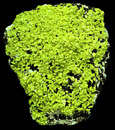|
|
| Formula: | Ca(UO2)2(PO4)2•10-12H2O |  Click to see a larger image |
||
| Crystal: | Tetragonal | |||
| Hardness: | 2-2.5 | |||
| Spec. Gr.: | 3.1-3.2 | |||
| Streak: | Yellowish | |||
| Cleavage: | Perfect basal and Prismatic | |||
| Location: | Autun, France |
| Autunite is a calcium uranium phosphate, a so-called uranium "mica" which has weathered from primary uranium ores. Autunite is fairly common, and in large accumulations it is mined as a uranium ore. A sample of autunite will contain up to 62 percent UO3. Autunite crystallizes in perfectly cleavable plates. While appearing much like its "sister" torbernite, its color is yellowish-green rather than green, and its crystals are usually smaller. Autunite fluoresces strongly under ultraviolet light. Autunite was named after the uranium ore deposit in Autun, France. Other localities which have produced good autunite crystals are Malacacheta, Minas Gerais, Brazil; Beltana mine, South Australia; Jáchymov, Czechoslovakia; and ores recently discovered in the vicinity of Great Bear Lake, at Port Radium, in Canada's Northwest Territory. |
|
Bibliography: Svenek, Jaroslav, Minerals, 1987, pg. 168-169. Vanders, Iris, Mineral Recognition, 1967, pg. 251. |
|
University of California, Santa Barbara—Department of Earth Science Copyright © 2005 Regents of the University of California Send your comments to the Web Page Editor |